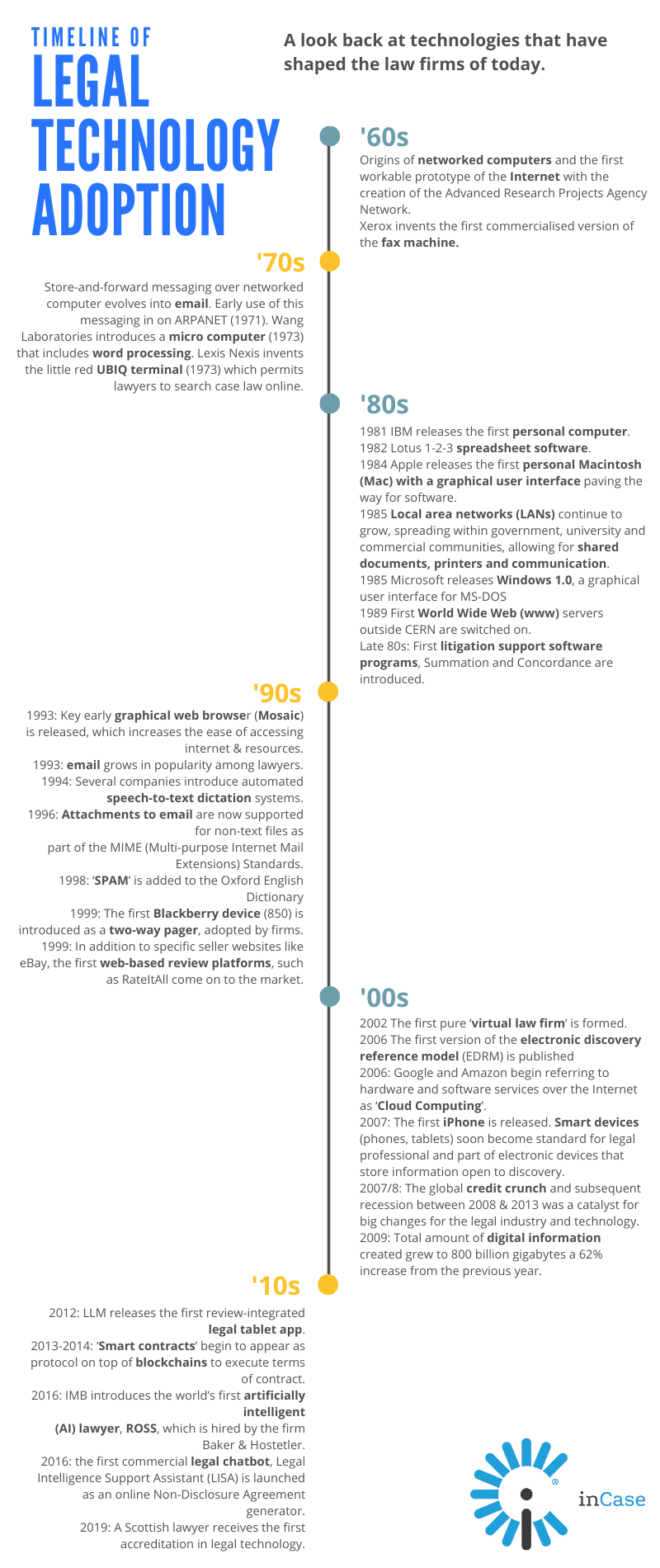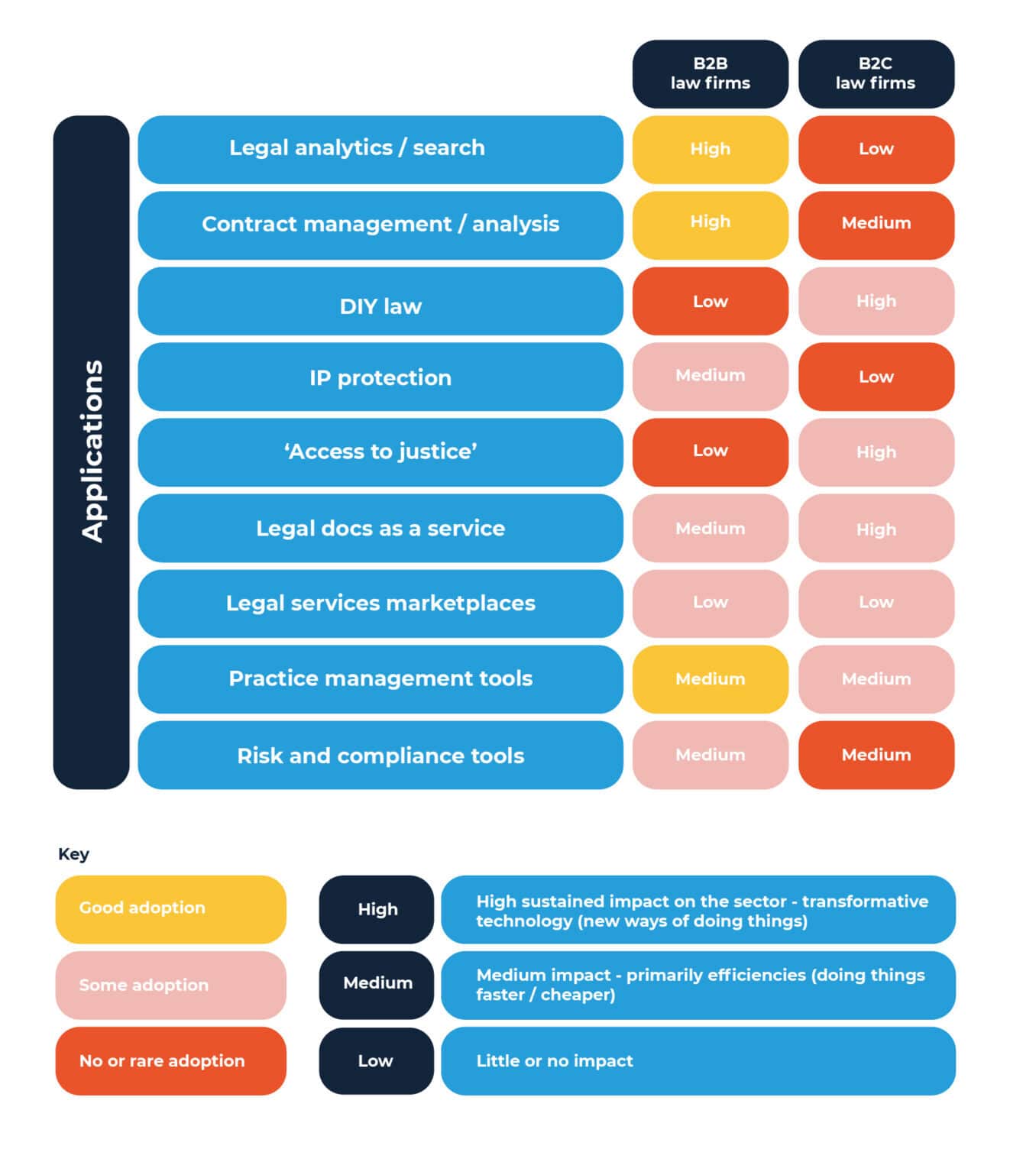 Posted by Rob Hosier, Sales and Marketing Director at Legal Futures Associate inCase
Posted by Rob Hosier, Sales and Marketing Director at Legal Futures Associate inCase
Compared to other professional services, the legal sector has historically been a slower adopter of technology, predominantly due to risk-averse practitioners, the partnership model and a the billable hours model – promoting slow sifting through precedents and casework, as well as minimal time to explore the adoption of new technology and learn new tools.
Today, thankfully, UK law firms are catching up other professional services sectors, such as banking with mobile apps and other technology, which we will explore in more detail. However, the sector is still facing unprecedented challenges that demand rapid attention and adaptation. Client expectations are changing while the amount of lawtech is increasing, and new entrants are successfully fusing the two together to cost-efficiently provide a more enticing customer experience.
In fact, research undertaken by the Law Society into lawtech adoption found that, although a ‘diverse but fragmented ecosystem’ of lawtech start-ups had emerged, smaller firms had tended to shun disruptive technology that can offer clients a new way of accessing the law.
In this article we look at:
- technological milestones in the legal sector since the computer came onto the scene;
- the latest tech being adopted by law firms; and
- how you can successfully implement new technology in your practice.
Key technological milestones in the legal sector
We could start with Goose quills and ink, printing presses and carbon paper or even the first typewriters, but the modern day technological advances in law firms have come from the computer revolution.
The computer revolution in the legal sector began in the early 1970s, when Lexis invented the red ‘UBIQ’ terminal to let lawyers search case law online rather than painstakingly poring through physical books. The revolution quickly moved from document searching to document creation when Wang introduced a computer dedicated to word processing.
For large firms, the arrival of Wang systems and their proprietary Wang word processing was a game-changer that revolutionised the document creation process. Law firms began to realise the efficiencies of centralised document storage and word processing moved from a back office function into the hands of everyone at the firm who wanted access.
In the timeline image you can see a whole host of milestones over the past 80 years, which, depending on your age you can reminisce on. For millennials, you may need to Google many of these inventions!
Despite such a plethora of progress within law firms, it’s worth noting that legal has generally been the laggard sector, even initially resisting the Internet. But often client demands lead to progress, e.g. with the internet, a requirement to communicate via with e-mail and rapidly growing awareness of the web caused most law firms to connect.
Legal technology has made great strides in the last decade — and the pace only seems to be quickening. By early 2000s, for the first time, many firms had infrastructure comparable to their corporate clients, where technology became woven into the fabric of law firms. Most recently, last year a Scottish lawyer become the first in the UK to receive an accreditation in legal technology, marking a new milestone in lawtech.
Also, in response to Covid-19 The Law Society launched their ‘Return, Restart, Recovery’ campaign to support the national recovery effort and reinforce the role solicitors and their firms will play, with one key focuses being ‘lawtech support and advice for law firms who might be struggling with technology’.
History has shown that resisting technology will only impede progress and viability. As the legal landscape continues to shift, firms must secure their position by using the technology available, thereby improving efficiency, saving money, increasing profitability and ultimately giving them a competitive edge in a crowded space.
Legal technology adoption timeline

What is the latest technology being adopted by UK law firms?
2019 saw tremendous growth and significant lawtech developments in the legal sector, which were predicted to continue to grow throughout 2020 – even before the current pandemic accelerated the need to communicate and engage with clients virtually. A recent report revealed that lawtech as a sector is growing 6% every year, with adoption increasing as the legal workforce becomes more mobile, younger and tech-savvy.
The common critique that law firms do not embrace digital transformation both for themselves and their clients is certainly not representative for the top 30 firms in the UK. However, as B2B commercial firms with turnover in the 100s of million, lawtech is more affordable; so, what is being embraced by smaller firms including those operating in the B2C sphere?
Lawtech covers a wide range of tools, helping to achieve competitive advantage such as: document automation, e-discovery software, data analysis and extraction, smart legal contracts, chatbots, and many others.
Systems are already available that can draft documents, undertake legal research, disclose documents in litigation, perform due diligence, provide legal guidance and resolve disputes online. Here is a deep dive into a few areas where lawtech is currently being adopted and the potential benefits to your firm.
Cloud based infrastructure
Law firms differ greatly in where they currently sit on their cloud journeys, with primary drivers for a firm’s adoption of cloud including client pressure, desire for lower more flexible costs and better usability. According to the Law Society’s Lawtech Adoption Research this is often expedited when legacy on-premise document, case or practice management systems come to their ‘end of life’ and firms look at doing something differently and testing the market for cloud-based solutions.
Movement to the cloud acts as a competitive advantage for technology-focused law firms looking to reduce infrastructure and IT staff costs, while improving:
- Security
- Accessibility (incl. supporting remote working)
- Collaboration (from anywhere in the world)
- Resilience (backup/recovery and less downtime)
- Flexibility (e.g. up/down scale data requirements)
- Access to the most up-to-date technology
When it comes to Case and Practice Management Software (CMS & PMS), there are a number of genuine Software as a Service (SaaS) offerings (i.e. fully-managed and maintained by the vendor, low subscription costs and automatic updates with minimal downtime) such as Thomson Reuters Elite 3E being used by medium to large firms to Aderant Expert Sierra being used small to medium sized firms.
The Law Society’s report, Capturing Technological Innovation in Legal Services, outlines how many firms are spending a disproportionate amount of their IT budget on simply making sure all their legal business software applications continue to work together. The benefit of adopting a platform approach means main IT components are resolved by a major IT player (for example, Microsoft). This lowers the cost for firms to gain access to the latest software and upgrades, ensures different systems speak fluently to each other and brings an ability to bolt on future new lawtech start-up solutions developed on (or compatible with) the same platform.
Automated processing
Robotic process automation (RPA) is one of the most advanced forms of business process automation technology, based on metaphorical software robots (bots) or on artificial intelligence (AI), that allow anyone today to configure computer software, or a ‘bot’ to emulate and integrate the actions of a human interacting within digital systems to execute a business process. The benefit of RPA or any type of automation is the cost to serve being slashed and increased speed in progressing cases.
One legal area that automation has lent itself nicely to is volume conveyancing, which is extremely cost competitive and allows a firm to meet increasing client expectations around the customer experience. Automation examples include Land Registry integration tools (automatic title checking), production of welcome packs, and mobile app services sharing information such as project milestones or automated notifications with the client.
The introduction of new regulations to the legal sector, such as anti-money laundering (AML) and GDPR are also driving the need for process automation and/or the deployment of lawtech solutions. Compliance has become a core business process for financial services organisations and, while in legal services it remains ancillary, there are some law firms that are investing in lawtech solutions to avoid having to continue spending money putting people in place and tolerating often long delays in client onboarding.
The inCase mobile app for instance has a ID / AML feature built in, where law firm clients using the app follow a simple eight step process to prove their identity, making the client onboarding fast & convenient for all parties, while giving the firm peace of mind regarding compliance.
Client experience of accessing legal services
 Consumers of legal services are no longer comparing their digital experience with your peers, they are ranking you across all sectors, i.e. including the likes of Amazon who deliver exceptional customer experience, in a way that customers want through its website, app and social media. A number of lawtech providers, such as inCase are developing mobile solutions specifically for B2C law firms, but uptake prior to Covid-19 was mixed as many firms remained reluctant to invest in technology even when consumer behaviour and expectation was more advanced than what is currently being offered by law firms.
Consumers of legal services are no longer comparing their digital experience with your peers, they are ranking you across all sectors, i.e. including the likes of Amazon who deliver exceptional customer experience, in a way that customers want through its website, app and social media. A number of lawtech providers, such as inCase are developing mobile solutions specifically for B2C law firms, but uptake prior to Covid-19 was mixed as many firms remained reluctant to invest in technology even when consumer behaviour and expectation was more advanced than what is currently being offered by law firms.
The implications of Covid-19 have undoubtedly accelerated technology adoption, with technology vendors such a Microsoft witnessing “two years’ worth of digital transformation in two months”. Search insights on Google Trends show that consumer behaviours have become increasingly digital. Whether for transactional, educational, or personal purposes, it is clear that people have turned to digital channels for many aspects of their lives. As a result, consumers are no longer expecting only the experience they were offered before, instead they have developed much higher digital expectations.
This is why all businesses, regardless of vertical or size, need to accelerate their digital adoption and transform their operations to meet consumers where they are now — and give them the experience they expect.
Firms that use our inCase app are testament that embracing lawtech in the right way can have significant benefits to your clients’ experience.
“Clients are asking for more frequent contact with their lawyers. They want to be kept up to date, they want to know what is happening and they don’t think that telephoning is the best method of communication anymore. inCase helps solve this and puts lots of different technologies in one easy to access location for clients. We are able to keep in constant contact with our clients, without our lawyers doing anything more than they presently do. Clients can upload documents, provide electronic signatures and complete questionnaires all through inCase. It really has brought our services into the 21st century.”
Tom Parkinson, Rowlinsons Solicitors
Research by the Law Society suggests that the self-service law with minimal interaction with lawyers is not that far away, with one of their respondents quoted as saying: “We would like to become a self-service law provider enabling individuals to do conveyancing via an app on their phone, with notifications, payment through Android or Apple Pay”.
As an extension of self-service, DIY law expands the boundaries of the legal sector by increasing the accessibility, affordability and automation of simple legal transactions, e.g. uncontested online divorces from firms such as QuickieDivorce and will writing online and grants of probate from firms like Farewill.
Chatbots
 A chatbot is quite simply a computer programme or an Artificial Intelligence which conducts a conversation via ‘auditory’ (e.g. Amazon Alexa) or ‘textual’ (e.g. website pop up) methods online. They respond to words it recognises allowing you to converse to some degree and in the legal sector providing simple legal information with options for direct engagement with legal practitioners.
A chatbot is quite simply a computer programme or an Artificial Intelligence which conducts a conversation via ‘auditory’ (e.g. Amazon Alexa) or ‘textual’ (e.g. website pop up) methods online. They respond to words it recognises allowing you to converse to some degree and in the legal sector providing simple legal information with options for direct engagement with legal practitioners.
There has been an increasing amount of activity in the B2C chatbot space over the last twelve months following a slow start, with current B2C examples including DoNotPay, with a ‘robo-lawyer’ that fights parking tickets, Robot Lawyer LISA to create legally binding non-disclosure agreements (NDAs) or virtual assistants that can help onboard new clients.
Major benefits of chatbots include:
- Client intake: Chatbots can offer significant aid to the client intake process. Through ‘discussion trees’ that make use of a multiple-choice format, chatbots can quickly elicit valuable information. That information can help identify the right lawyer within the firm to handle their matter (like a specialist in employment discrimination or medical malpractice). All information gathered through the chat can then be forwarded to the appropriate attorney ahead of the initial consultation.
- Appointment scheduling: Those initial consultations can be scheduled through the chatbot, eliminating the involvement of lawyers or receptionists.
- Understanding your client base: The questions that visitors ask a chatbot can help a law firm gain insight into its client base. If chatbot logs reveal that a firm keeps getting asked about a complementary practice area for instance, it could reveal a promising direction for growth.
- Use your content to inform visitors: Many firms produce great content on their websites without actively sharing it. Chatbots are a great delivery vehicle for that library of content, which can establish a lawyer’s thought leadership.
Chatbots do not require a huge amount of change management (often being layered over the top of existing processes); therefore, although not necessarily transformative technology, it does make it one of the more accessible forms of lawtech right now.
Summary of current lawtech adoption by potential transformative impact over a five-year time horizon, from Law Society’s Lawtech Adoption Research report, February 2019.

How to successfully implement technology in your practice
So, you have identified new technology for your firm, most likely to improve productivity, efficiency, and performance; however, how you choose to introduce those technologies can make or break their success.
With careful preparation, strategic implementation, and honest evaluation, new technology can be seamlessly integrated and painlessly adopted by all your people. Here are a few tips for getting the most out of your next technology rollout:
Before signing on the dotted line
When committing to new technology or any form of digital transformation, the Law Society recommend you know:
- That cyber security and GDPR provisions are in place;
- How the solution you are considering, and its support process survives testing in your organisation;
- The extent of support from the vendor for your user environment;
- What happens to your data at the end of the contract?
- The training your staff will require;
- How to measure the Return on Investment (ROI).
Create your project plan
Technology implementations should be treated like any ‘change’ project, with clear goals and a written project plan. There are numerous project management tools and approaches to help, the key is to take the time to develop a formalised document that outlines the project’s objectives, identifies key stakeholders, delineates roles and responsibilities and provides a general outline for approaching the project.
Map out the user journey
Failing to understand and map out how a new solution will fit into existing user journey risks making the experience worse for those you intend to use it. One of the ways you can ensure your new technology performs from the get-go is to map out all the different user journeys with your new solution at the beginning of the implementation process, which will also help when communicating how your new lawtech will work once rolled out.
Identify key practice areas and select one for a pilot
Unless the technology is specifically for one proactive area, consider the current needs and processes of each practice to determine which are best suited to the new lawtech. To ensure successful adoption, secure senior level sponsorship together with setting out the case for change and the benefits it will deliver to all staff – getting them excited about the new lawtech that will be available to them. Once you’ve identified practice areas that will benefit from your technology programme, narrow it down to a single practice group with which to pilot your programme, where you’ll gain valuable feedback and lawtech ‘champions’ that will help when rolling it out efficiency to other areas.
Market your law tech internally prior to launch
Drive adoption of your programme by building awareness, interest and engagement amongst lawyers and staff. Some effective marketing activities and tactics might include developing a brand for your project, sharing early success stories from the pilot group or an online demo/webinar to preview the new lawtech. Then once you’ve successfully developed, tested, and marketed the lawtech, it’s time for launch. Ensure that appropriate training is given to all users, as it’s crucial to determining the long-term success of the project.
On going user engagement
Ongoing training, education and appropriate communication channels for gathering feedback and input from users will help to maintain interest and desire to get the best from your lawtech. As your legal teams learn more about it’s capability, they’ll discover new features and tools that can help them be more productive and efficient.
Evaluate performance
Last, but no least, it’s important to evaluate the outcome of the implementation to assess the success and identify any risks to learn from for future roll outs. This can be a combination of feedback from the project group and 1-2-1s or surveys with users conducted one or two months after implementation.
Summary
While lawtech is certainly gaining traction as a whole, it remains less mature than other fields of digital disruption, most notably fintech, where funding and regulatory alignment are more advanced. Lawtech is currently less ‘disruptive’ technology-wise and the opportunities for UK firms are more focused on automation and creating efficiencies than on delivering ‘new types of law’.
Despite more advanced consumer behaviour and expectations, lawtech still has a relatively low penetration rate across all segments of the law, with the business-to-consumer (B2C) legal market lagging behind in particular. Therefore, the opportunity is there for innovative firms to steal a march right now, particularly those with volume commoditised services – where automation is principally about driving efficiencies.
And if you’re planning to introduce new technology within your firm, there are several key steps to consider – from carefully planning your project to gathering honest feedback.
To find out about how our inCase mobile app is helping firms throughout the UK deliver transformational efficiency and customer service improvements, download the inCase App Brochure 2020.













Leave a Comment